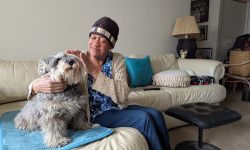Michigan nursing homes linked to 1 in 4 coronavirus deaths. Tally will grow.

LANSING — Michigan Gov. Gretchen Whitmer’s coronavirus pandemic policies for nursing homes have been “an epic fail,” a Democratic lawmaker said Wednesday as state officials disclosed incomplete new data linking 1 in 4 COVID-19 deaths long-term care residents.
State Rep. Leslie Love, D-Detroit, said her mother contracted COVID-19 in a nursing home last week and questioned whether Whitmer’s policies jeopardized vulnerable residents by requiring facilities to create units for patients discharged from hospitals or send them to other nursing homes designated as regional hubs.
“I’m so appreciative of what the governor has done to try to keep us all safe... but when it comes to the decisions around our nursing facilities, I think we have an epic fail,” Love said during emotional testimony before the Senate Oversight Committee.
- The latest: Michigan coronavirus map, curve, chart, updated COVID-19 news
- Dashboard: Michigan coronavirus testing numbers, trends, COVID-19 data
- Gov. Gretchen Whitmer extends Michigan stay-at-home order through June 12
- Small gatherings, non-essential doctors' visits now allowed, Gov. Whitmer says
“To have them integrate [COVID-19 patients] into those communities, I think puts our senior citizens at harm.”
Robert Gordon, director of the Michigan Department of Health and Human Services, defended the state’s response as he shared preliminary data showing at least 1,216 nursing home residents had died from coronavirus complications as of Friday, either in their facilities or after being transferred to a hospital. That accounts for 23 percent of the state’s total deaths.
There have been at least 4,920 COVID-19 cases linked to nursing homes, about 9 percent of the statewide total.
But that data, reported under new state guidelines designed to mirror federal standards, is incomplete, Gordon told lawmakers on the oversight panel, which has spent weeks examining nursing home pandemic policies.
As of Friday, 434 of 499 nursing homes expected to provide COVID-19 data to the state had done so.
In Wayne County — which includes Detroit, an early epicenter of the pandemic in Michigan — only 73 percent of facilities had reported COVID-19 data requested by the state. Because of that reporting gap, the state data only includes 374 deaths from Wayne County nursing homes even though local health officials have identified 674 deaths there.

“It’s a very large gap,” Gordon acknowledged. “And that tells us that we’re going to find out about more deaths.”
The virus has wreaked havoc in nursing homes across the country, spreading through facilities where elderly residents with pre-existing conditions are more likely to die.
As of May 11, nursing home residents and workers accounted for one-third of all COVID-19 deaths in the United States, according to an analysis by the New York Times.
If additional data already reported to local officials in Wayne, Oakland and Macomb counties are confirmed to the state, nursing home residents will account for closer to 30 percent of all deaths in Michigan, Gordon said.
“Candidly, it will be higher than that as well as we get the non-reporting facilities in the rest of the state,” he told lawmakers.
Policy switch
Whitmer first issued an executive order for nursing homes on April 15, more than a month after officials confirmed the state’s first case of the novel coronavirus. The order required nursing homes at less than 80 percent capacity to create dedicated units for “COVID-19 affected residents” and mandated they take in new patients so long as they had “appropriate” personal protection equipment for employees.
Love and a small group of other Democratic lawmakers two weeks ago submitted proposed policy revisions to Whitmer, and on Tuesday she thanked the governor for adopting some of those ideas in a new executive order signed last week.
Whitmer’s revised order requires nursing homes to “make all reasonable efforts to create a unit dedicated to the care and isolation of COVID-19-affected residents” but no longer makes that mandatory. The order also specifies that nursing homes should not accept the return of a hospitalized COVID-19 resident if they do not have a dedicated unit to care for them.
“We’re doing everything in our power to protect people who don't have COVID from getting infected by people who do, given the facilities we have and given the need to treat people in facilities that are appropriate for them,” Gordon said.
As Bridge Magazine has reported for weeks, Michigan has been under fire to release more information about the coronavirus in nursing homes.
For the first six weeks of the pandemic, the state didn’t even list nursing homes with suspected COVID-19 cases. At one point, health officials said doing so would cause “undue stress” on homes.
Even now, the data are limited, reflecting only current cases in homes rather than total cases and the number of residents who have recovered.
On Friday, Michigan began collecting information about admissions, testing, staff cases, staffing shortages, and discharges in ways that comply with new federal requirements, said Lynn Sutfin, spokesperson for the Michigan Department of Health and Human Services.
Additionally, the state requires nursing homes to submit information about their personal protective equipment and numbers of residents each transfers to regional hubs.
Sutfin acknowledged Wednesday that it’s still not clear how deaths will be publicly released — by nursing homes, at a county level or even at a state level.
The department is weighing the demand from the public for detailed information against privacy concerns for residents in smaller facilities, Sutfin said.
“We are looking to CMS for guidance on this,” she said. “There are questions still on how deaths will be reported.”
Demands for greater transparency
As AARP and other advocates have demanded greater transparency in nursing homes nationally, estimates of COVID-19 deaths in nursing homes have varied, with one estimate claiming long-term care facilities account for 43 percent of all COVID-19 deaths.
Pennsylvania – where about 69 percent of that state’s deaths are reported to be in nursing homes and assisted living facilities – lists COVID-19 nursing home deaths both by county as well as by individual nursing home. It first disclosed that list on May 19.
New York began releasing the number of COVID-19 deaths by individual nursing home in early May, though its reported share of coronavirus deaths among nursing home residents – at about 14 percent of the overall total – is thought to be low because the state does not count residents who die in the hospital.
In Michigan, state Rep. Peter Lucido, R-Shelby Township, has argued the state can’t protect nursing home residents with limited information. He has asked both state Attorney General Dana Nessel and federal prosecutors to investigate the state’s nursing home policies.
“Everybody’s asking me how many people died in the nursing facilities as a result of mixing COVID with non-COVID [residents,]” Lucido said Tuesday, questioning why the state still does not have complete data.
Marianne Udow-Phillips, executive director of the Center for Health Research and Transformation at the University of Michigan, said the disclosure of death counts by nursing homes should be a trigger for further action.
She said the state could leverage that information to form nursing home “strike teams,” as states including Maryland have done. Since early April, Maryland has sent teams composed of hospital health care workers, National Guard members and state and local health care workers to nursing homes with COVID-19 outbreaks. The teams assist with testing and provide on-site medical support.
“The state could be deploying these teams to help with infection control. It’s something the state could be working with the nursing home, to have these traveling teams to be available,” she said.
Kate Massey, MDHHS senior deputy director for the Medical Services Administration, said the state expects “close to 100 percent” of nursing homes will be reporting COVID-19 data within two weeks.
The Michigan Elder Justice Initiative, a Lansing-based nonprofit advocacy organization, continues to hear from distraught family members of nursing home residents, said Alison Hirschel, managing attorney.
They fear loved ones could be exposed to the virus, but remain the dark about what’s going on inside because they are not allowed to visit, she said.
“They are not feeling confident about whether COVID is in the facility. They looked in the window and they don’t think the staff is wearing masks and not using PPE,” Hirschel said.
Hirschel called full disclosure of nursing homes of deaths from COVID-19 “incredibly important.”
“I think we were a little slow in the beginning to figure out the mechanics for this to be reported. A lot of it was being reported to local health departments, but it wasn’t clear to me it was being reported to the state,” she said.
She questioned whether reported deaths by nursing homes can be trusted when that information is released: “I don’t know if there is going to be any auditing of that information. I’m not confident it will be accurate.”
Under federal guidance, the Michigan Department of Licensing and Regulatory Affairs suspended routine nursing home inspections during the pandemic but has continued sending teams into facilities for infection control surveys.
Inspectors have so far visited 327 Michigan nursing homes for infection control surveys, LARA Director Orlene Hawks told lawmakers Tuesday.
Of those, 17 were inspected a second time to determine if residents were in “immediate jeopardy.” The state health department has designated 20 nursing homes as regional hubs to care for elderly COVID-19 patients. Of those, 13 have been inspected so far, Hawks said.
To date, the state has received 2,216 complaints about Michigan nursing homes so far this year, up from 1,766 complaints at the same point in 2019.
See what new members are saying about why they donated to Bridge Michigan:
- “In order for this information to be accurate and unbiased it must be underwritten by its readers, not by special interests.” - Larry S.
- “Not many other media sources report on the topics Bridge does.” - Susan B.
- “Your journalism is outstanding and rare these days.” - Mark S.
If you want to ensure the future of nonpartisan, nonprofit Michigan journalism, please become a member today. You, too, will be asked why you donated and maybe we'll feature your quote next time!








